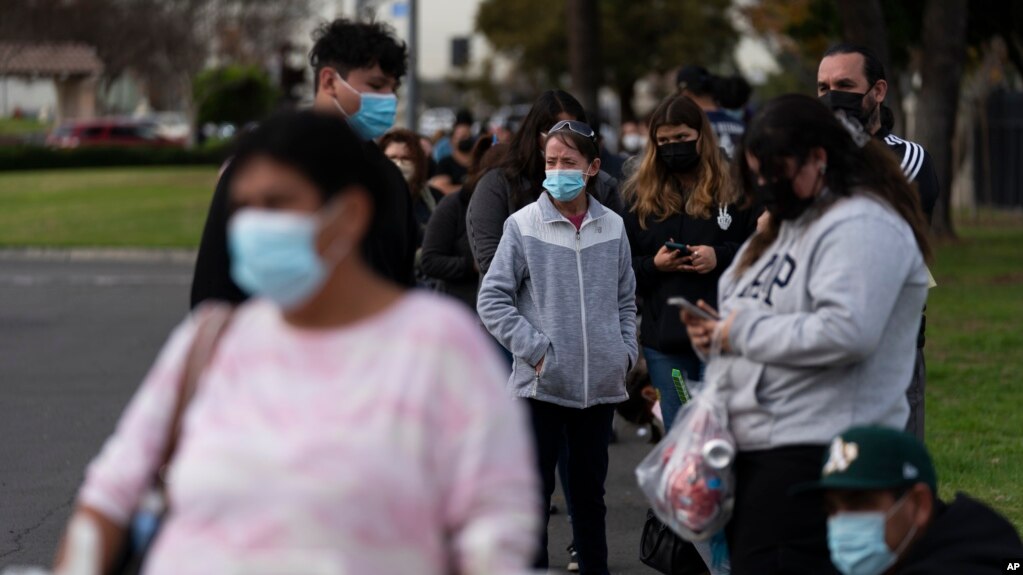
FILE – People wait in line for a COVID-19 test at a mobile testing site in Paramount, California, Jan. 12, 2022. (AP Photo/Jae C. Hong)
Scientists warn that the fast-spreading Omicron will likely not be the last worrisome version of the coronavirus.
The Omicron version of the coronavirus was first identified in mid-November. By the first week of January, the World Health Organization reported a record 15 million new COVID-19 cases. That is a 55 percent increase from the previous week.
Every new infection provides a chance for the virus to mutate, or change. The fast spread of Omicron means the virus has more chances to develop new versions, called variants.
Scientists do not know what the next variants will look like or how they might shape the pandemic. But they say there is no guarantee that new coronavirus variants will cause milder illness or that existing vaccines will work against them. And they urge wider vaccination now, while the shots still work against the virus.
Dr. Leonardo Martinez is an infectious disease expert at Boston University. He said, “The faster Omicron spreads, the more opportunities there are for mutation, potentially leading to more variants.”

More contagious, breakthrough infections
Research shows that Omicron is at least two times as contagious as the Delta variant and four times more contagious than the original version of the virus. Contagious means the variant could easily pass between people.
Omicron is also more likely than Delta to reinfect individuals who previously had COVID-19 and to cause “breakthrough infections” – meaning to cause an infection even if a person is vaccinated.
The variant’s quick spread increases the chances that the virus will infect and remain inside people with weakened immune systems – giving it more time to develop mutations or changes.
Dr. Stuart Campbell Ray of Johns Hopkins University said, “It’s the longer…infections that seem to be the most likely breeding grounds for new variants.” He added more infections also increased the chances for that to happen.

Other possibilities for the virus
Since Omicron appears to cause less severe disease than Delta, there is hope that it could make the virus milder like a common cold. It is a possibility, experts say, given that viruses do not spread well if they kill their hosts very quickly. But viruses do not always get less deadly over time.
Ray explained that a variant could realize its main goal – replicating or reproducing – if it caused mild infections at first then caused severe illness later. This would give time for an infected person to spread the virus to others before getting very sick.
Ray added, “I don’t think we can be confident that the virus will become less lethal over time.” Lethal is a term that means deadly.
When SARS-CoV-2, the virus that caused COVID-19, first appeared, no one was immune. But infections and vaccines have given at least some immunity to much of the world, so the virus must change to survive and spread to others.
There are many possible ways for such change to take place.
Animals could possibly release new variants. Dogs and cats, deer and farm-raised mink are some of the animals that could be infected by the virus. The virus could mutate within them and then jump back to people.
Another possibility is that people could get infected with both Omicron and Delta at the same time. Such infections could create what Ray calls “Frankenvariants” with qualities of both variants.
When new variants do develop, scientists said it is still very difficult to know which ones might spread. For example, Omicron has 30 mutations that let it attach easily to human cells. But the IHU variant, identified in France, has 46 mutations and does not seem to have spread much at all.
To control or limit the spread of new variants, scientists stress continuing with public health measures such as wearing face coverings and getting vaccinated.
Louis Mansky is director of the Institute for Molecular Virology at the University of Minnesota. He said with so many unvaccinated people, “the virus is still kind of in control of what’s going on.”
I’m John Russell.
Laura Ungar reported on this story for the Associated Press. John Russell adapted it for Learning English.
_____________________________________________________________
Words in This Story
opportunity – n. an amount of time or a situation in which something can be done
mutation – n. biology : a change in the genes of a plant or animal that causes characteristics that are different from what is normal; a new form of something that has changed
contagious – adj. able to be passed from one person or animal to another by touching
immune system– n. the system that protects your body from diseases and infections